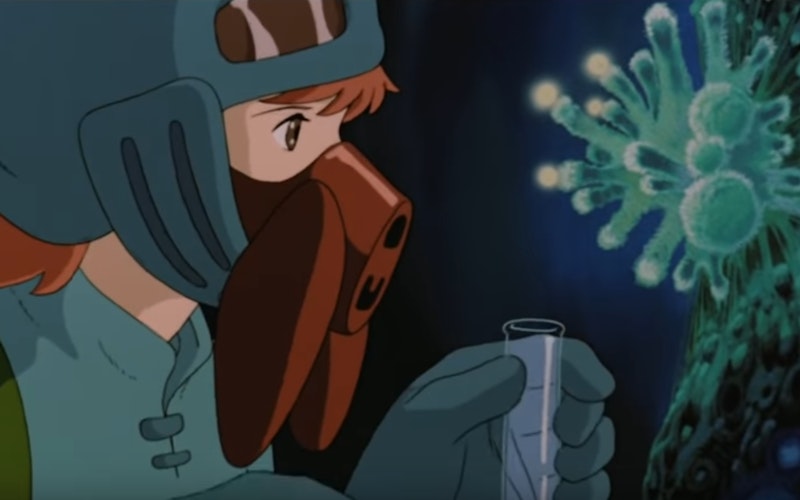
Movies
Nausicaä’s Cultural Mandate
Released 35 years ago, the Japanese animated film Nausicaä of the Valley of the Wind still has much to teach us about living in harmony with nature. Part of that timelessness has to do with the fact that the movie echoes a biblical perspective on creation care.
After recently watching this often-overlooked Studio Ghibli film, I contemplated humanity’s relationship with our planet—and how that relationship can be a fraught topic these days. I support recycling and buying sustainably sourced products, but I have a hard time calling myself part of the "green movement" when I see members valuing eagle eggs over unborn babies.
In Nausicaä of the Valley of the Wind, the titular character is the princess of Earth 1,000 years in the future. Man-made giant warriors have caused a nuclear holocaust that nearly destroyed every living thing. Toxic jungles now spread across the land, making it more hostile. At the beginning of the film, Nausicaä explores a jungle filled with mutated giant insects and a myriad of fungi. Though she knows its imminent danger (exposure to certain spores would be lethal), she is fascinated by the flora and fauna’s beauty.
Indeed, nature is an amazing thing. It’s majestic, terrifying, beautiful, and otherworldly all at the same time. God created countless animals before he created mankind. Many Bible passages speak of the beauty of creation. In the beginning, God declared all things “good.” He adores his creation and I adore it too. I’ve found myself stopping to look at the intricate patterns of a flower and marveling at its perfection. I’ve observed, in admiration, the stealthy design of a praying mantis.
Yet humanity also has its value and wonder. And Nausicaä has a heart for her people. When she returns home to the Valley of the Wind, she helps her people with daily tasks, spends time with those she’s closest to, and protects the villagers and other humans from intruders—even from nature itself. When an ohmu, a whale-sized insect, chases her friend Yupa, she uses a whistling insect charm to calm the ohmu, saving both Yupa and the insect from harm.
God adores his creation and I adore it too.
Hayao Miyazaki, the writer and director of Nausicaä, captures all of this in his unique animation style, painting the poisonous fungi with detail that rivals today’s computer-generated imagery and inventing costume and creature designs that stand out from other anime films. Miyazaki’s movies often include themes of environmental protection, from Princess Mononoke to My Neighbor Totoro. “I’d like more of the world [to] go back to being wild,” he told The Telegraph in 2009. Yet he also clearly values humanity; his films highlight strong human relationships and almost always focus on a human character’s journey.
Christians understand that God made humanity in his image. Our creator loves nature, but he also highly values humankind. “Consider the ravens,” Jesus said. “They do not sow or reap, they have no storeroom or barn; yet God feeds them. And how much more valuable you are than birds!” Humans are valuable and not to be secondary to nature. And yet that doesn’t mean our planet should be ravaged for resources or that animals exist for our exploitation.
In Miyazaki’s film, Nausicaä’s ideals are tested when she encounters situations where humanity clashes with nature. The film’s antagonist, Kushana, believes that people have the right to destroy nature. On the other hand, Oh-Baba, The Valley of the Wind’s shaman, believes the earth has the right to annihilate humans if necessary. At the climax of the film, Kushana and her warriors have partially resurrected one of the great warriors from the past and Oh-Baba witnesses its awesome destructive power. Shocked and ashamed, Oh-Baba says, “The earth knows it’s wrong for us to survive if we have to depend on a monster like that.”
A legend in Nausicaä’s culture says, “After a thousand years of darkness he will come clad in blue when surrounded by fields of gold to restore mankind’s connection to the earth that was destroyed, and he will guide the people of this planet at last to a land of purity.” Nausicaä fulfills this prophecy as she finds a way to bring humanity and earth together. Through experimentation, she discovers water and soil that’s been purified by an underground, petrified forest. Using these materials, she manages to cultivate fungi from the toxic jungle that are benign, halting the toxic jungle’s spread. She creates an environment where the insects and humans can live harmoniously, a new Heaven and Earth where all of creation flourishes.
With the cultural mandate of Genesis, God made us stewards of this wondrous earth, entrusting Adam to name the animals and cautioning us all against exploiting them. Nausicaä inspires me to value nature, while still remembering that humans are separate and made in the image of God. Both are beautiful creations.
Topics: Movies